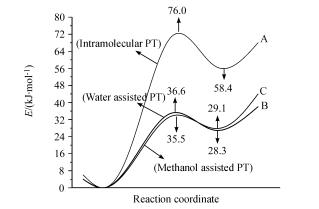化学学报 ›› 2011, Vol. 69 ›› Issue (15): 1743-1750. 上一篇 下一篇
研究论文
杨国辉1, 李言信1, 颜世海*,1,2, 代丽1, 赵斌*,1
Yang Guohui1; Li Yanxin1; Yan Shihai*,1,2; Dai Li1; Zhao Bin*,1

研究了2-[(4-氯苯基亚氨基)甲基]-8-羟基喹啉的三种质子转移途径: 分子内质子转移、水分子辅助质子转移和甲醇分子辅助质子转移. 以该席夫碱化合物的晶体结构作为模型, 在B3LYP/6-31+G(d)水平上, 优化得到稳定态和过渡态的几何构型. 对三类质子转移前后的结构、能量、红外光谱、化学位移进行研究, 结果表明水分子辅助质子转移和甲醇分子辅助质子转移中, 水和甲醇分子利用氢键作用参与质子转移过程, 形成七元环状过渡态, 大大降低了反应的能垒, 有利于质子的转移, 氢键在降低活化能方面起着重要作用.